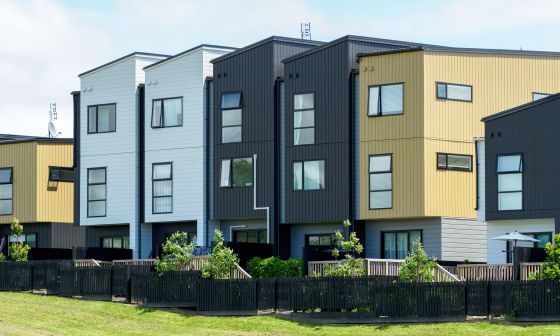
First thing’s first. What’s the deal with interest rates?
Last month, the Reserve Bank brought in its third 50-point Official Cash Rate (OCR) increase this year, taking it from 2% to 2.5%. At the same time, the bank’s Monetary Policy Committee reiterated the projection from its May Monetary Policy Statement that the OCR could now peak at 4%, instead of 3.5%, as previously thought – meaning we have, possibly, another 1.5% to go.
The mistake lots of people make with that is assuming the increase is just going to be added onto current mortgage rates. If that were true, we’d be heading for rates up over 7%. And for most of us, especially those who are already stretched, it’s a terrifying thought.
But, as a general rule, mortgage rates sit about 2% above the OCR. That means, if the OCR hits 3.5% or 4%, mortgage rates should tap out at around 5.5% or 6%. But most housing rates are already over 5%. So, in other words, most of the increase is already there.
That’s why, despite the general sense of panic out in the market at the moment, I’m solidly of the view that interest rates have started to stabilise, and we should see things settle down later this year.

Wherever interest rates peak, they won’t stay there for long
If you think of the economy like a car engine, the Reserve Bank’s job is to strike a balancing act, keeping the engine at a point where it’s neither overheating nor stalling.
With inflation wreaking havoc, we’re very clearly in an overheating phase right now. And the aggressive moves we’re seeing to raise the OCR (and interest rates) are an appropriate and sure-fire way to bring that into check.
But I’d be very surprised if we see the OCR hit that suggested peak of 3.5% or 4%. That’s because, according to the Reserve Bank, a “neutral” OCR (a.k.a. one which supports a stable economy) is 2%, and “neutral” mortgage rates around 4%.
With mortgage rates already well above that, we’re well into the tightening cycle. And I suspect we’ll see the economy slow down a lot faster than anticipated, against a backdrop where business is already struggling, and consumer confidence is low.
As soon as that happens, and inflation is out of the economy, you can expect to see interest rates start to ease back to around that 4% point.
If I was going to offer up one question mark in all of this, it’d be around immigration.
We don’t quite know how quickly immigration is going to pick up, or to what degree. But high levels of immigration will have a really strong stimulatory effect on the economy. And that’ll also serve to support house prices, simply because we don’t have enough stock.

Falling ‘absolute’ house prices
When it comes to house prices – don’t buy into the media headlines. News stories are reporting a fall in house prices of between 3%-4% and, increasingly, we’re seeing predictions that the market could fall by up to 20% from last year’s highs. But those headlines aren’t actually telling the full story.
If you were out to buy today, you’d already be seeing prices 10% below where they were last year – but I suspect it’ll be another few months before that reality filters through to the news cycle.
And as for this predicted 20% drop? There’s some important nuance behind those figures that isn’t being discussed, making those numbers sound a lot scarier than they need to.
Roughly half of that estimated 20% dip will be thanks to a fall in absolute house prices. In other words, a house that would’ve cost you $1.5 million to buy last year might cost you just over $1.3 million today.
This is great news for buyers, of course, because it means you’re having to borrow less from the bank. But this drop is also what’s hitting homeowners in the pocket, especially those who bought at last year’s market peak.
As I mentioned, what we’re seeing in the market right now would suggest most of this fall’s come through already. So, for buyers, I wouldn’t be holding my breath for absolute prices to drop much further.

Falling ‘real’ house prices
That other 10% comes down to a drop in “real” house prices. All a drop in real house prices means is that, in the current inflationary environment, house prices aren’t going up in the same way that the cost of other goods is going up.
At the risk of sounding like one of those math word problems… that means if you were to buy a property with cabbages (or bottles of milk, or blocks of butter), that property would cost you fewer cabbages (or bottles of milk, or blocks of butter) this year than it would have 12 months ago.
If you already own a property, a drop in “real” house prices means nothing. But for anyone looking to get onto the property ladder, that drop is doing some pretty heavy lifting in terms of helping to make housing more affordable.
That’s because one of the (few) benefits of high inflation is that it drives wage and salary increases. Particularly in the current environment. As unemployment is so low, many businesses are going through a pretty aggressive salary increase cycle – we’re talking 4%-5% – to help retain talent.
Over time, this shift serves to slowly correct the issue of massively over-inflated asset prices, as we’ve seen across our housing market in recent years.
None of that’s to say that inflation is good news. One of the biggest challenges is that salary increases quite often lag inflation, resulting in a “cost of living crisis” like the one we’re seeing at the moment.

Developers and house prices
The developer scene has been a major driving force behind Auckland house prices. When we talk about a drop from “peak” market, we’re not actually looking at the average or the norm. Often that high watermark is set by a really small number of transactions in a particular area, while the bulk of sales sit well below that level.
In Auckland, and especially South Auckland and parts of the North Shore, a lot of peak sales in recent years have been in the development space. That’s people paying record amounts of money ($1.5 million to $1.6 million) for 800m² plots of dirt, so they can turn them into terraced townhouses, and on-sell them to first-home buyers for $800k-$900k each.
The immense growth in Auckland house prices over the last few years is really a reflection of growing land values – driven in large part by this extremely active terraced housing developer market snapping up land left, right and centre.

And there are a few things behind this. Prior to the GFC, a lot of the activity on Auckland’s development scene was in the high-rise space. As far as developments go, apartment buildings are hugely complicated. And if you don’t have enough capital, the consequences of being caught out by a downturn in the market are massive.
When the GFC struck, we saw a lot of high-rise developers lose their shirts, taking finance companies down with them. After that, appetite for risk in the developer market took a real hit. Understandably.
And because terraced housing developments are far less risky, and need far less capital behind them, they’ve really become the sweet spot for the developer market.
(The truth is Kiwis aren’t ready to fully embrace apartment living anyway, not when we’re only just learning to let go of the quarter-acre dream. And so terraced housing has become kind of the sweet spot for entry-level housing, too.)
With less risk involved, and lower barriers to entry, we’ve seen a flood of new players get in on the developer game. And it’s these guys – the newbies – who really drove up land prices last year, paying $200k to $300k more for land than what a seasoned developer might’ve done.
 Price falls and the market
Price falls and the market
As with any shift, not all parts of the market will be equally impacted by price falls. Right now, the greatest level of risk is around development land, simply because of the massively over-inflated prices we were seeing last year.
Developers who have run out of funds halfway through a project will feel this the most, given the limited market they’re selling to. And once the house has been removed, the most likely buyer is another developer.
I’d expect entry level housing prices will be underpinned by ongoing high construction costs, so there should be very little movement in that space.
It’s at the higher end of the market – in those premium areas like Ponsonby and Herne Bay – that we’re starting to see the bigger shifts, as buyers feeling the impact of higher interest rates are more motivated to sell. Although this, too, may change once immigration starts to pick up again.
 John Bolton founded Squirrel in 2008. He is a former General Manager at ANZ, where he was responsible for the bank’s $60bn of retail lending and deposits. He has 10 years of senior banking experience behind him in financial markets, treasury, finance, and strategy, and is a director of Financial Advice New Zealand, the industry body for financial advisers. Check out Squirrel’s website for how Squirrel helps first home buyers, here.
John Bolton founded Squirrel in 2008. He is a former General Manager at ANZ, where he was responsible for the bank’s $60bn of retail lending and deposits. He has 10 years of senior banking experience behind him in financial markets, treasury, finance, and strategy, and is a director of Financial Advice New Zealand, the industry body for financial advisers. Check out Squirrel’s website for how Squirrel helps first home buyers, here.
Enjoy reading this article?
You can like us on Facebook and get social, or sign up to receive more news like this straight to your inbox.
By subscribing you agree to the Canstar Privacy Policy




Share this article